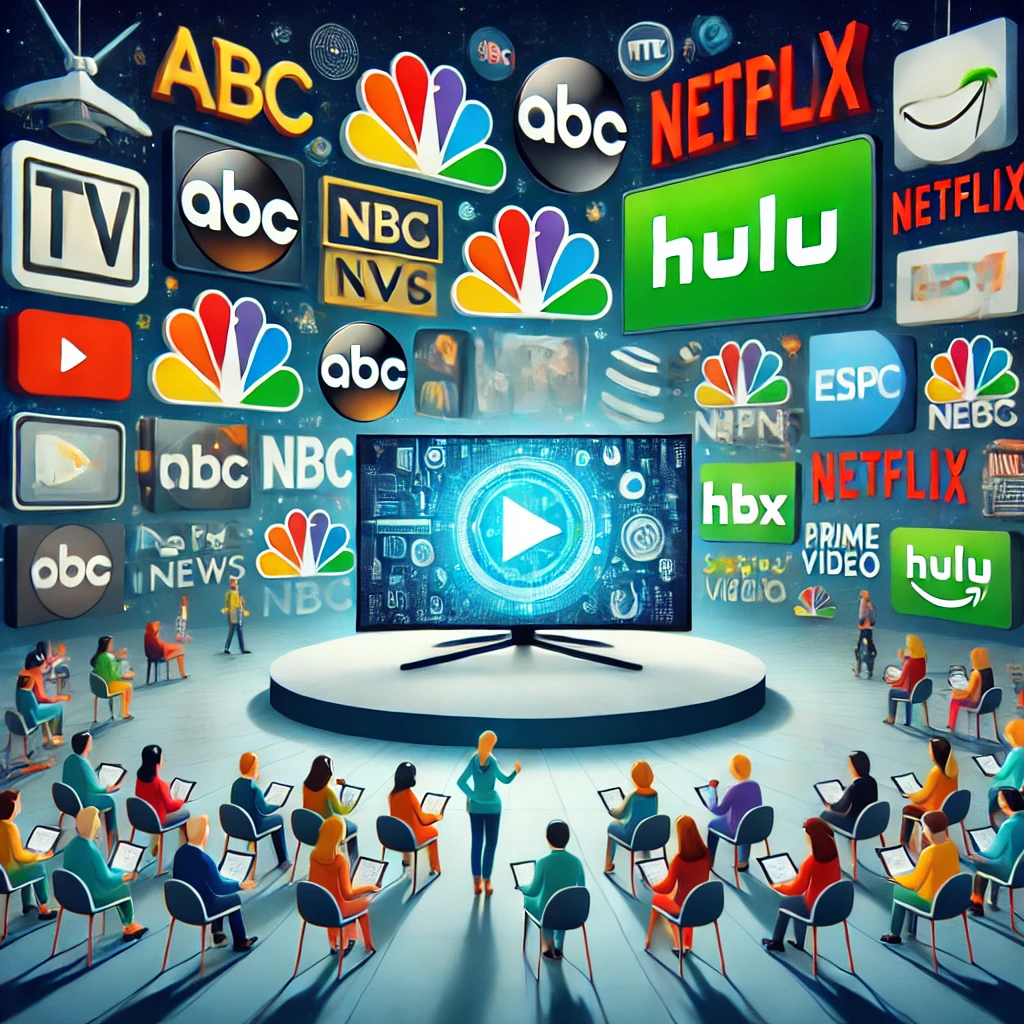
Where to Advertise Business or Services to a Television Audience

Advertising to a television audience remains one of the most powerful ways to reach a broad and engaged group of consumers. Despite the rise of digital platforms, television advertising holds a unique place in the marketing landscape due to its ability to deliver impactful, visual storytelling to a large number of people in a short amount of time. For businesses and services, television can help generate widespread brand awareness and drive customer action. This report explores where businesses and services should focus their efforts when advertising to a television audience, considering traditional broadcast channels, cable, and modern streaming services.
1. Traditional Broadcast Networks
Traditional broadcast television, delivered through major networks like ABC, NBC, CBS, and FOX in the U.S. or BBC and ITV in the UK, remains a vital channel for advertising. These networks offer an enormous reach, particularly for businesses looking to target a general audience across diverse demographics. Despite the growth of online media, network television retains a dominant share of viewership, especially for live events, news broadcasts, and popular prime-time shows.
Key Benefits:
- Massive Audience Reach: Networks deliver content to millions of homes, making them one of the most effective tools for achieving broad brand recognition.
- Prime-Time Slots: Advertisements aired during prime-time (typically between 8-11 p.m.) capture the highest concentration of viewers. Shows like dramas, reality TV, and talk shows command millions of loyal fans, offering a prime opportunity for exposure.
- Event Advertising: Events like the Super Bowl, World Cup, or the Oscars draw some of the largest global television audiences, making these high-profile events ideal for maximum brand exposure.
Target Audience:
Businesses that advertise on traditional broadcast networks typically target a broad audience or seek to create national or regional brand recognition. Common industries include automotive, consumer electronics, fast food chains, and pharmaceutical companies.
Costs:
Broadcast network advertising can be expensive, especially during prime-time or during high-profile events. For example, a 30-second spot during the Super Bowl can cost millions of dollars. However, even smaller, regional businesses can find more affordable slots during local news or daytime television programs.
2. Cable Television
Cable networks offer a more segmented audience than traditional broadcast networks. Popular cable channels include CNN, ESPN, MTV, and HGTV, each of which caters to a specific niche or demographic. The rise of cable television has given advertisers the opportunity to target viewers based on their interests more effectively.
Key Benefits:
- Targeted Audiences: Advertisers can select cable channels that align with their target audience. For instance, a home improvement company may benefit from advertising on HGTV, while a financial services company might prefer to advertise on CNBC.
- Diverse Content: Cable networks offer a wide array of content ranging from news, sports, lifestyle programming, and children’s entertainment. This diversity allows advertisers to match their message with the type of programming that best resonates with their intended audience.
- Lower Costs: Compared to traditional broadcast networks, cable advertisements are often more affordable, particularly for smaller businesses looking to reach a regional or national audience on a budget.
Target Audience:
Cable television is an excellent platform for businesses looking to reach specific market segments. For example, a fitness product might advertise on a sports channel like ESPN, while a luxury brand may focus on advertising on lifestyle channels like E! or Bravo.
Costs:
The cost of advertising on cable varies significantly based on the popularity of the channel and the time slot. Advertisers can pay anywhere from a few hundred to several thousand dollars for a 30-second spot, depending on the reach and audience segmentation of the channel.

3. Streaming Platforms
With the growing popularity of streaming services like Netflix, Hulu, Amazon Prime Video, and Disney+, many businesses are shifting their advertising efforts to these platforms. While some streaming services (like Netflix) do not feature traditional advertisements, others like Hulu and Peacock offer ad-supported subscription tiers that present opportunities for businesses to reach viewers in a new and innovative way.
Key Benefits:
- On-Demand Viewing: Streaming platforms allow users to watch content on their own schedule. This on-demand behavior means viewers are often more engaged with the programming they choose to watch, leading to higher retention of advertisements.
- Programmatic Advertising: Many streaming platforms offer programmatic advertising, which uses data and technology to target specific viewer demographics with personalized ads. This ensures that businesses can deliver relevant content to the right people at the right time.
- Cross-Platform Reach: Many viewers consume streaming content across multiple devices, such as smart TVs, tablets, and mobile phones. This flexibility allows advertisers to reach their audience in various contexts, whether they are watching at home or on the go.
Target Audience:
Streaming services appeal to a younger, tech-savvy demographic, including millennials and Generation Z viewers. Brands that want to connect with these groups should consider placing ads on streaming platforms. Additionally, these platforms are ideal for businesses looking to implement precise targeting, such as e-commerce companies or direct-to-consumer brands.
Costs:
The cost of advertising on streaming services varies based on the platform, audience targeting options, and campaign goals. For example, Hulu’s ad rates range from $20 to $30 per thousand impressions, making it accessible to businesses of various sizes. Streaming platforms often offer more flexible budgets than traditional TV.
4. Local TV Stations
Advertising on local television stations is another effective way for businesses to reach a geographically targeted audience. Local stations often have loyal viewership in specific regions, especially during morning shows, local news broadcasts, and regional sports events. For small and medium-sized businesses with a limited budget, local television advertising can offer a cost-effective alternative to national broadcast or cable networks.
Key Benefits:
- Geographic Targeting: Local TV allows businesses to concentrate their advertising efforts in a specific geographic area, making it perfect for businesses that serve a local market or have multiple locations in different regions.
- Community Engagement: Many viewers turn to local stations for regional news, weather updates, and local interest stories, fostering a sense of trust and community. Businesses that advertise on these stations can benefit from the viewer’s affinity for local programming.
- Lower Costs: Advertising on local stations is generally more affordable than national networks, especially if targeting specific regions or metro areas. It offers businesses with smaller advertising budgets a chance to reach their target customers.
Target Audience:
Local TV advertising is well-suited for businesses that want to attract customers within a specific geographic area, such as retail stores, restaurants, automotive dealerships, and healthcare providers.
Costs:
Local TV ad costs can vary widely based on the market size, with smaller regions offering more affordable rates. A 30-second ad spot on a local news program in a mid-sized city might cost between $200 and $1,500.
5. National vs. Regional Advertising
When choosing where to advertise, businesses must decide whether they want to focus on national or regional television campaigns. National campaigns, typically on major broadcast or cable networks, provide extensive exposure but at a higher cost. Regional campaigns, which air on local stations or during specific geographic windows on national networks, are more targeted and can be more cost-effective.
National Campaigns:
- Ideal for large companies with wide-reaching products or services.
- Best for creating brand awareness on a national scale.
- Costly, particularly for prime-time slots and major events.
Regional Campaigns:
- Best for small-to-medium businesses or large companies targeting specific areas.
- More affordable, especially on local stations.
- Allows businesses to target audiences based on geographic preferences.
Conclusion
Advertising to a television audience offers significant opportunities for businesses of all sizes. Traditional broadcast networks remain an excellent choice for reaching a broad, general audience, while cable television provides the advantage of targeting specific demographics. Streaming platforms, with their growing popularity and programmatic advertising options, allow businesses to engage with tech-savvy, younger viewers on multiple devices. For businesses with smaller budgets or localized operations, local TV stations present a cost-effective way to advertise within a specific geographic area.
In deciding where to advertise, businesses should evaluate their target audience, budget, and campaign goals. The evolution of television and video consumption habits requires advertisers to be flexible, taking advantage of both traditional and digital options to reach viewers effectively. Whether through traditional broadcast, cable, or streaming services, television advertising remains a powerful medium for businesses to connect with consumers and grow their brand.



